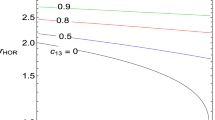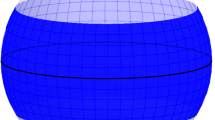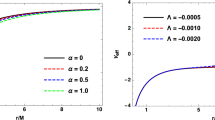Abstract
We study the exact evolution of the orbital angular momentum of a massive particle in the gravitational field of a Kerr black hole. We show analytically that, for a wide class of orbits, the angular momentum’s hodograph is always close to a circle. This applies to both bounded and unbounded orbits that do not end up in the black hole. Deviations from the circular shape do not exceed \(\approx 10\%\) and \(\approx 7\%\) for bounded and unbounded orbits, respectively. We also find that nutation provides an accurate approximation for those deviations, which fits the exact curve within \(\sim 0.01\%\) for the orbits of maximal deviation. Remarkably, the more the deviation, the better the nutation approximates it. Thus, we demonstrate that the orbital Lense–Thirring precession, originally obtained in the weak-field limit, is also a valid description in the general case of (almost) arbitrary exact orbits. As a by-product, we also derive the parameters of unstable spherical timelike orbits as a function of their radii and arbitrary rotation parameter a and Carter’s constant Q. We verify our results numerically for all the kinds of orbits studied.






Similar content being viewed by others
Notes
From the viewpoint of intrinsic geometry, the plane is, of course, not flat and has a nonvanishing curvature. Also note that the “Cartesian” coordinates are different from the Kerr–Schild coordinates.
The precession of the axis of a gyroscope [8] which is also referred to as the Lense–Thirring effect is not pertinent to this Paper (see also a discussion of certain analogies between the two effects in Conclusion).
Another factorization proposed in [17] can be convenient if the sum \(Q + (L_z - aE)^2\) is used instead of the Carter’s constant.
The precession of a gyroscope on essentially relativistic bounded orbits around a Kerr black hole was studied in [34]. However, the explicit expressions are quite cumbersome (even when restricted to the case of equatorial plane), and the properties of the nutation in this fully relativistic case are not evident.
References
Landau, L.D., Lifshitz, E.M.: The Classical Theory of Fields. Pergamon Press, Oxford (1975)
Farina, C., Kort-Kamp, W.J.M., Mauro, S., Shapiro, I.L.: Phys. Rev. D 83, 12 (2011). https://doi.org/10.1103/physrevd.83.124037
Misner, C.W., Thorne, K.S., Wheeler, J.A.: Gravitation. W.H. Freeman and Co., San Francisco (1973)
Frolov, V.P., Novikov, I.D.: Black Hole Physics: Basic Concepts and New Developments. Kluwer Academic, Dordrecht (1998)
Visser, M.: The Kerr spacetime: a brief introduction (2007). arXiv: gr-qc/0706.0622
Lense, J., Thirring, H.: Zeit. Phys. 19, 156 (1918)
Mashhoon, B., Hehl, F.W., Theiss, D.S.: Gen. Relativ. Gravit. 16(8), 711 (1984). https://doi.org/10.1007/bf00762913
Schiff, L.I.: Phys. Rev. Lett. 4(5), 215 (1960). https://doi.org/10.1103/physrevlett.4.215
Wilkins, D.C.: Phys. Rev. D 5(4), 814 (1972). https://doi.org/10.1103/physrevd.5.814
Goldstein, H.: Zeitschrift für Physik 271(3), 275 (1974). https://doi.org/10.1007/bf01677935
Teo, E.: Gen. Relativ. Gravit. 35(11), 1909 (2003). https://doi.org/10.1023/a:1026286607562
Giannoni, F., Masiello, A.: Nonlinear Anal. Theory J. Funct. Anal. 101(2), 340 (1991). https://doi.org/10.1016/0022-1236(91)90162-x
Masiello, A.: Nonlinear Anal. Theory Methods Appl. 19(6), 531 (1992). https://doi.org/10.1016/0362-546x(92)90019-b
Hasse, W., Perlick, V.: J. Math. Phys. 47(4), 042503 (2006). https://doi.org/10.1063/1.2188209
Chandrasekhar, S.: The Mathematical Theory of Black Holes. Clarendon Press/Oxford University Press, Oxford/New York (1983)
Carter, B.: Phys. Rev. 174(5), 1559 (1968). https://doi.org/10.1103/physrev.174.1559
Krivenko, O.P., Pyragas, K.A., Zhuk, I.T.: Astrophys. Space Sci. 40(1), 39 (1976). https://doi.org/10.1007/bf00651187
Bardeen, J.M., Press, W.H., Teukolsky, S.A.: Astrophys. J. 178, 347 (1972). https://doi.org/10.1086/151796
Jefremov, P.I., Tsupko, O.Y., Bisnovatyi-Kogan, G.S.: Phys. Rev. D 91, 12 (2015). https://doi.org/10.1103/physrevd.91.124030
Landau, L.D., Lifshitz, E.M.: Mechanics. Pergamon Press, Oxford (1969)
Hairer, E., Nørsett, S.P., Wanner, G.: Solving Ordinary Differential Equations I. Nonstiff Problems. Springer, Leipzig (2008)
Ciufolini, I., Pavlis, E.C.: Nature 431(7011), 958 (2004). https://doi.org/10.1038/nature03007
Everitt, C.W.F., DeBra, D.B., Parkinson, B.W., Turneaure, J.P., Conklin, J.W., Heifetz, M.I., Keiser, G.M., Silbergleit, A.S., Holmes, T., Kolodziejczak, J., Al-Meshari, M., Mester, J.C., Muhlfelder, B., Solomonik, V.G., Stahl, K., Worden, P.W., Bencze, W., Buchman, S., Clarke, B., Al-Jadaan, A., Al-Jibreen, H., Li, J., Lipa, J.A., Lockhart, J.M., Al-Suwaidan, B., Taber, M., Wang, S.: Phys. Rev. Lett. 106, 22 (2011). https://doi.org/10.1103/physrevlett.106.221101
Reach, W.T., Lisse, C., von Hippel, T., Mullally, F.: Astrophys. J. 693(1), 697 (2009). https://doi.org/10.1088/0004-637x/693/1/697
Koester, D., Dreizler, S., Weidemann, V., Allard, N.F.: Astron. Astrophys. 338, 612 (1998)
Ciufolini, I., Paolozzi, A., Pavlis, E.C., Ries, J.C., Koenig, R., Matzner, R.A., Sindoni, G., Neumayer, H.: Space Sci. Rev. 148(1–4), 71 (2009). https://doi.org/10.1007/s11214-009-9585-7
Pepe, F., Molaro, P., Cristiani, S., Rebolo, R., Santos, N., Dekker, H., Mégevand, D., Zerbi, F., Cabral, A., Marcantonio, P.D., Abreu, M., Affolter, M., Aliverti, M., Prieto, C.A., Amate, M., Avila, G., Baldini, V., Bristow, P., Broeg, C., Cirami, R., Coelho, J., Conconi, P., Coretti, I., Cupani, G., D’Odorico, V., Caprio, V.D., Delabre, B., Dorn, R., Figueira, P., Fragoso, A., Galeotta, S., Genolet, L., Gomes, R., Hernández, J.G., Hughes, I., Iwert, O., Kerber, F., Landoni, M., Lizon, J.L., Lovis, C., Maire, C., Mannetta, M., Martins, C., Monteiro, M., Oliveira, A., Poretti, E., Rasilla, J., Riva, M., Tschudi, S.S., Santos, P., Sosnowska, D., Sousa, S., Spanó, P., Tenegi, F., Toso, G., Vanzella, E., Viel, M., Osorio, M.Z.: Astronomische Nachrichten 335(1), 8 (2014). https://doi.org/10.1002/asna.201312004
de Sitter, W.: Mon. Not. R. Astron. Soc. 76(9), 699 (1916). https://doi.org/10.1093/mnras/76.9.699
Bertotti, B., Ciufolini, I., Bender, P.L.: Phys. Rev. Lett. 58(11), 1062 (1987). https://doi.org/10.1103/physrevlett.58.1062
Shapiro, I.I., Reasenberg, R.D., Chandler, J.F., Babcock, R.W.: Phys. Rev. Lett. 61(23), 2643 (1988). https://doi.org/10.1103/physrevlett.61.2643
Mashhoon, B., Theiss, D.S.: Phys. Lett. A 115(7), 333 (1986). https://doi.org/10.1016/0375-9601(86)90625-0
Mashhoon, B., Theiss, D.S.: In Gyros, Clocks, Interferometers...: Testing Relativistic Gravity in Space, pp. 310–316. Springer, Berlin (2001). https://doi.org/10.1007/3-540-40988-2_15
Mashhoon, B., Theiss, D.S.: Il Nuovo Cimento B Series 11 106(5), 545 (1991). https://doi.org/10.1007/bf02726789
Bini, D., Geralico, A., Jantzen, R.T.: Phys. Rev. D 94, 6 (2016). https://doi.org/10.1103/physrevd.94.064066
Grib, A.A., Pavlov, Y.V.: Are black holes totally black? Gravitation. Cosmol. 21(1), 13–18 (2015). arXiv:1410.5736 [gr-qc]
Grib, A.A., Pavlov, Y.V.: High energy physics in the vicinity of rotating black holes. Theor. Math. Phys. 185(1), 1425–1432 (2015). arXiv:1503.04289 [gr-qc]
Johnston, M., Ruffini, R.: Phys. Rev. D 10(8), 2324 (1974). https://doi.org/10.1103/PhysRevD.10.2324
Meurer, A., Smith, C.P., Paprocki, M., Čertík, O., Kirpichev, S.B., Rocklin, M., Kumar, A., Ivanov, S., Moore, J.K., Singh, S., Rathnayake, T., Vig, S., Granger, B.E., Muller, R.P., Bonazzi, F., Gupta, H., Vats, S., Johansson, F., Pedregosa, F., Curry, M.J., Terrel, A.R., Roučka, v, Saboo, A., Fernando, I., Kulal, S., Cimrman, R.: PeerJ Comput. Sci. 3, e103 (2017). https://doi.org/10.7717/peerj-cs.103
Pérez, F., Granger, B.E.: Comput. Sci. Eng. 9(3), 21 (2007). https://doi.org/10.1109/MCSE.2007.53
Jones, E., Oliphant, T., Peterson, P., et al.: SciPy: Open source scientific tools for Python (2001). http://www.scipy.org/
Hunter, J.D.: Comput. Sci. Eng. 9(3), 90 (2007)
Van Der Walt, S., Colbert, S.C., Varoquaux, G.: Comput. Sci. Eng. 13(2), 22 (2011)
Sharp, N.: J. Comput. Phys. 41(2), 295 (1981). https://doi.org/10.1016/0021-9991(81)90098-x
Zakharov, A.F.: Mon. Not. R. Astron. Soc. 269(2), 283 (1994). https://doi.org/10.1093/mnras/269.2.283
Zakharov, A.F., Repin, S.V.: Astron. Rep. 43, 705 (1999)
Acknowledgements
The analytic part of this research was carried out by VNS and supported by a grant of the Russian Science Foundation (Project No. 17-71-10260). The numeric simulations were carried out by SKh. We are grateful to V.S. Beskin and Yu.Yu. Kovalev for providing a work environment which made completion of this Paper possible. We thank S.V. Repin for useful comments regarding the numerical simulation of geodesics and a presentation of this work before a committee. Last but not least, we thank an anonymous reviewer for pointing out (among other constructive comments) the analogy between the orbital Lense–Thirring precession and the precession of a gyroscope. Symbolic computations were partially performed with SymPy [38]. We also made use of IPython [39], SciPy [40], Matplotlib [41], and NumPy [42].
Author information
Authors and Affiliations
Corresponding author
Additional information
Publisher's Note
Springer Nature remains neutral with regard to jurisdictional claims in published maps and institutional affiliations.
Appendices
A Numeric solution of geodesic equations
The geodesic equations can be recast into a form that is more convenient for numeric simulations [43,44,45]. Although the number of equations increases, now there is no need to track signs of the square roots present in the initial form. The equations to be solved are
where \(d\tau /d\gamma =\rho ^2/E\), \(\xi = L_z/E\), and \(\eta =Q/E^2\). Also, the following relations hold between the functions:
This set of differential equations was numerically solved with either the classical or variable step [21] fourth-order Runge–Kutta method. That numeric solution was then used to draw the hodographs in Figs. 2, 3, 5, and 6. For convenience and reproducibility, we summarize the parameters for those hodographs in Table 2. Together with \(r_1\) and \(\theta _1\) evaluated through relations (73) and (74), they yield initial conditions for equations of motion (68)–(72). Also, we always choose \(r_1<0\) and \(\theta _1>0\) at the start.
B Behavior of functions E(y, a) and \(L_z(y,a)\) (the parameters of stable circular equatorial orbits)
Consider functions E(y, a) and \(L_z(y,a)\), which are given by (16) and (17), in the range \(y\in (0,1/r_{\mathrm{ph}}^{\pm })\). Their derivatives are
They vanish simultaneously at \(y = 1/r_{\mathrm{isco}}^{\pm }\), which satisfies [18]
Besides, \(E\rightarrow 1\) and \(L_z\rightarrow \pm \infty \) as \(y\rightarrow 0\), and \(E\rightarrow +\infty \) and \(L_z\rightarrow \pm \infty \) as \(y\rightarrow y_{\pm } = 1/r_{\mathrm{ph}}^{\pm }\). Therefore, at \(y = 1/r_{\mathrm{isco}}^{\pm }\), E(y, a) must have a minimum, and \(L_z(y,a)\) must have a minimum (maximum) at \(y = 1/r_{\mathrm{isco}}^{+}\) (\(y = 1/r_{\mathrm{isco}}^{-}\)). In other words, both E(y, a) and \(L_z^{2}(y,a)\) have a minimum at \(y = 1/r_{\mathrm{isco}}^{\pm }\).
C Parameters of unstable spherical orbits with \(E>1\) and arbitrary Q
Consider conditions (26) and (27) without omitting terms \(\propto q\equiv 1/Q\):
where \(\varDelta _y\equiv a^2y^2 - 2y + 1 > 0\).
Solving the second of the equations for \(\epsilon \) and subtituting the solution to the first equation leads to a quadratic equation with respect to \(x^2\):
where
Let us now study how solutions to the quadratic equation behave at \(y_{\pm }=1/r_{\mathrm{ph}}^{\pm }\). First, note that
Since \(C > 0\) and \(A\rightarrow 0^{-}\) as \(y\rightarrow y_{\pm }\), the roots of (80) have opposite signs. One of them tends to infinity and the other tends to a finite number. Their specific signs depend on the sign of K. If \(K>0\), the infinite root is positive and the finite root is negative. Otherwise, the infinite root is negative and the finite root is positive. If \(K=0\), both roots tend to infinities of opposite signs.
If \(q=0\) or, by continuity, \(q<<1\), then \(\lim \limits _{y\rightarrow y_{\pm }}{K}>0\), and at both \(y_{-}\) and \(y_{+}\) there is a positive infinite root. This root is the one that leads to solution (30)–(32) obtained under assumption \(q<<1\).
For arbitrary \(q>0\), it proves helpful to actually solve equation (80). A positive root is found from relation
At \(y_{+}\), which satisfies \(3y-1 = 2ay^{3/2}>0\), the coefficient that multiplies q is reduced as follows:
Hence, as soon as \(0<a<1\),
At \(y_{-}\), which satisfies \(3y-1 = -2ay^{3/2}<0\), the result depends on the magnitude of q. If \(q\ge -y(3y-1)/2 = ay^{5/2}\), a similar calculation leads to a right-hand side of (85) that vanishes as \(A\rightarrow 0^{-}\). Thus, in this case the root tends to a finite positive value. Otherwise, the root tends to an infinite positive value.
The function \(a[y_{-}(a)]^{5/2}\) grows in the range \(0\le a\le 1\) reaching its maximal value 1 / 32 at \(a=1\). Consequently, for a given \(a\in (0,1)\), there is a critical value of q that is below 1 / 32, which separates the cases of bounded and unbounded growth of \(x^2\) in a neighborhood of \(y_{-}\). Also, if q is sufficiently small, the growth is always unbounded, which corresponds to the limiting case represented by (30)–(32).
Another feature of \(x^2\) is that, for sufficiently small q, it vanishes at a point \(y_0\in (y_{-},y_{+})\) where it also reaches a minimum. Indeed, for \(q=0\) it is trivial to verify this. If \(q<<1, q\ne 0\), the minimum value must simultaneously satisfy equations
Since C and \(\partial C/\partial y\) have a common root, \(x^2=0\) satisfies this last set of equations at that common root and, by continuity, is a minimum of the non-negative function \(x^2\). The case of q that is large enough for the common root to become complex is beyond the scope of this article.
To ensure that \(\epsilon >0\), the following signs must be chosen for x:
Finally, the x found is used to evaluate \(\epsilon \) and \(\lambda _z\):
Note that \(\epsilon (y_0)\) is a well-defined number, because term 1 / x multiplies an expression that vanishes at that point. From (78), \(\epsilon (y_0) = \sqrt{(y_0^2 + q)\varDelta _y(y_0)}\).
As it was pointed out, for q that is small enough and \(0<a<1\), \(\lim \limits _{y\rightarrow y_{\pm }}{x^2}=+\infty \). Therefore,
In the last equation we have used the fact that the ratio does not depend on q. Indeed, if we divide (78) by \(x^2\), terms that contain q vanish as \(x^2\rightarrow +\infty \) and have no impact on the value of the limit.
Rights and permissions
About this article
Cite this article
Strokov, V.N., Khlghatyan, S. The orbital Lense–Thirring precession in a strong field. Gen Relativ Gravit 51, 82 (2019). https://doi.org/10.1007/s10714-019-2563-9
Received:
Accepted:
Published:
DOI: https://doi.org/10.1007/s10714-019-2563-9




